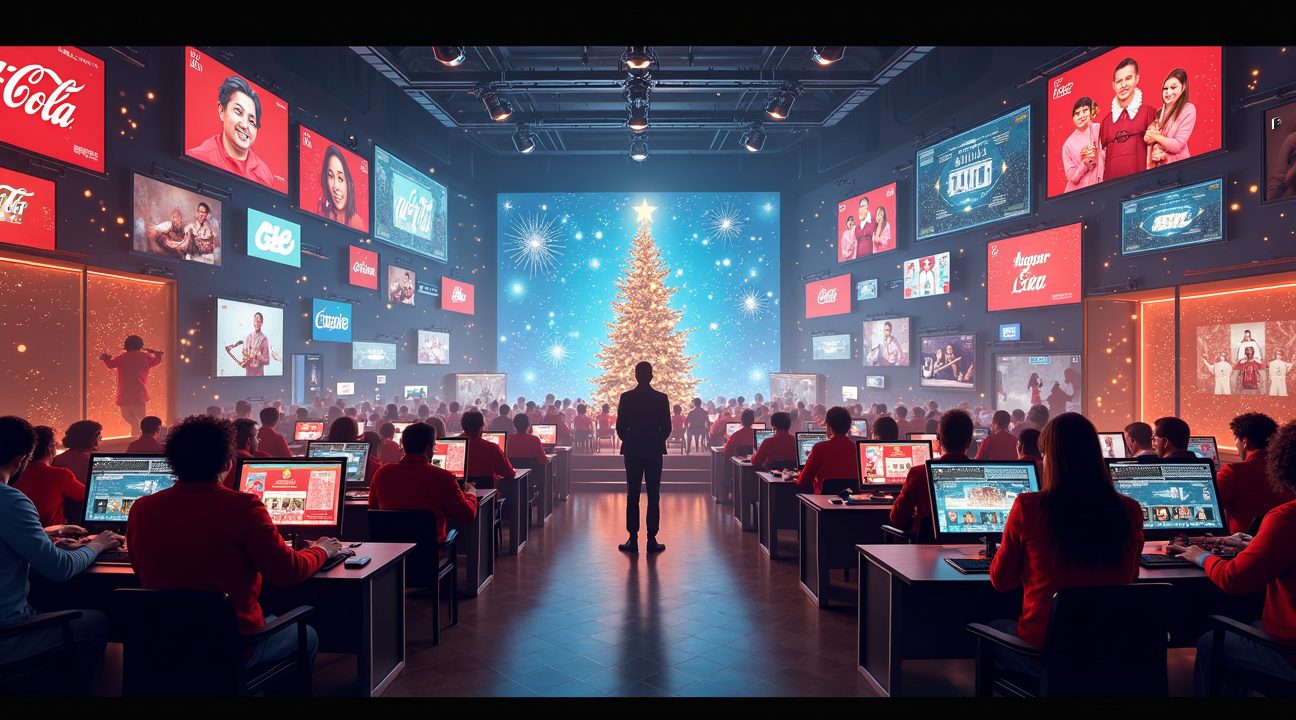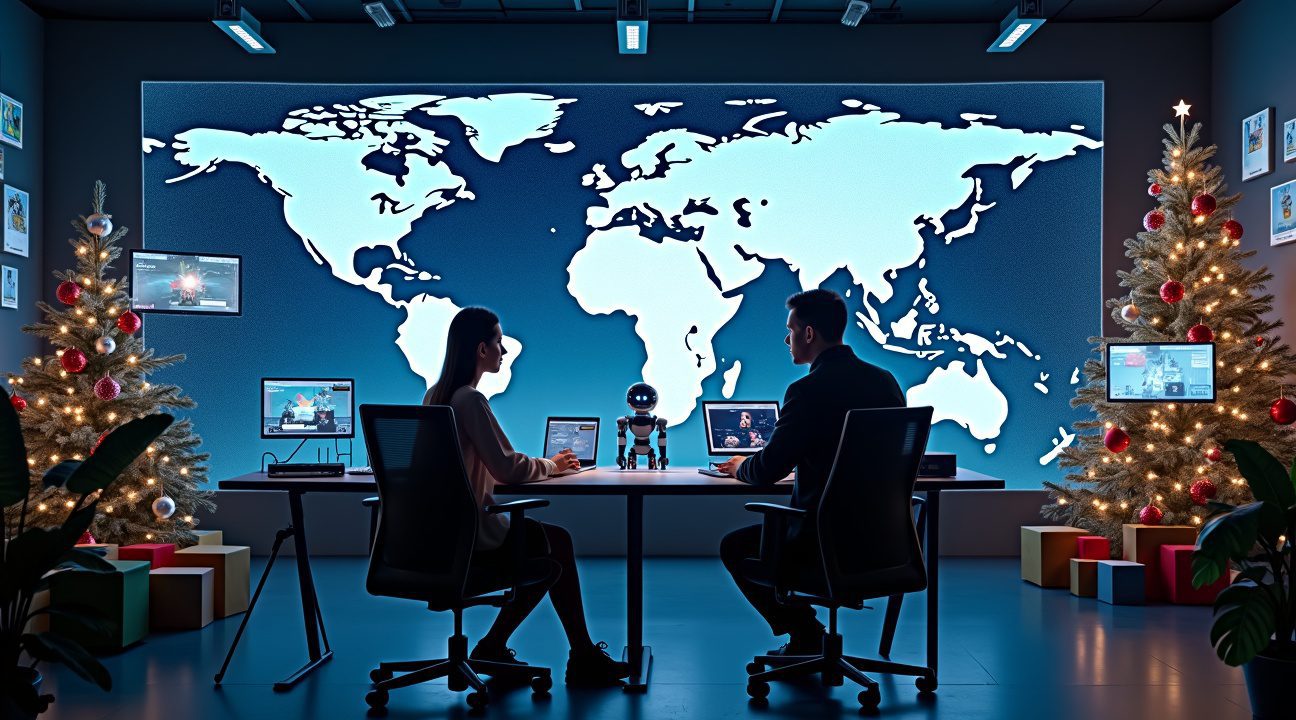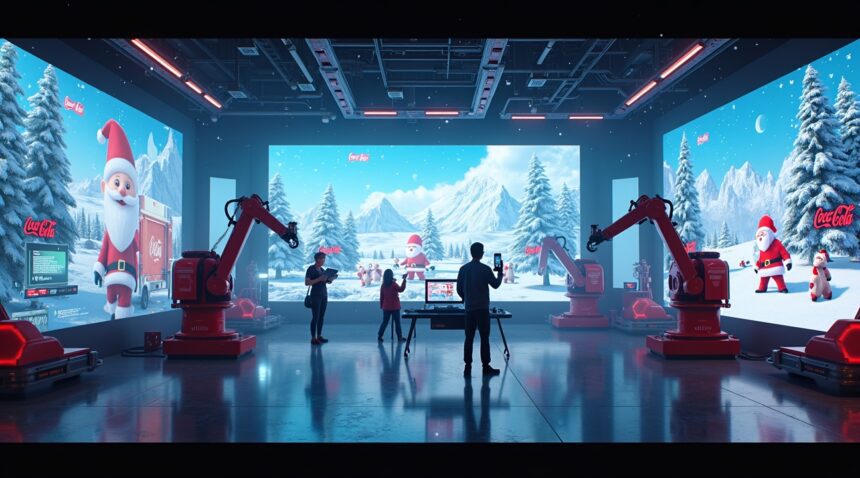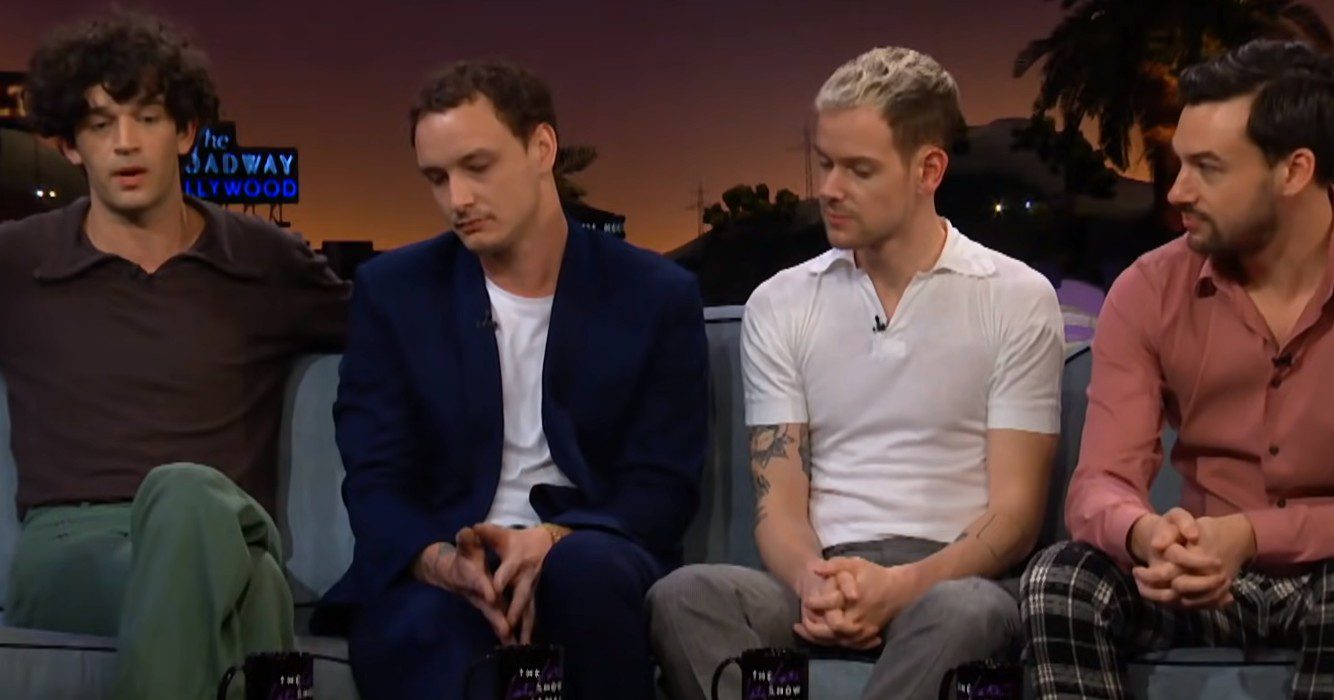Coca-Cola’s groundbreaking AI Christmas advertisement required an extensive production team of 100 people working with 70,000 AI-generated prompts over just 30 days, challenging assumptions that artificial intelligence simplifies creative processes.
The campaign demonstrates how major brands are embracing cutting-edge AI technology while maintaining significant human oversight to ensure both brand consistency and emotional authenticity.
Key Takeaways
- Massive scale production: The campaign generated over 70,000 AI video clips using multiple platforms including OpenAI Sora, Google Veo 3, and Luma AI, requiring five AI specialists to manage the content creation process.
- Human expertise remained essential: Despite AI handling video generation, approximately 100 people contributed specialized skills including creative direction, post-production, voice recording, and quality control that AI couldn’t replace.
- Mixed public reception: While System1 awarded the ad a perfect 5.9/5.9 rating for emotional impact, viewers criticized technical glitches like shape-shifting trucks, unnatural motion patterns, and unsettling facial features.
- Transparency as strategy: Coca-Cola openly shared their AI production process through behind-the-scenes content with AI narration, positioning themselves as industry pioneers rather than hiding the experimental technology.
- Industry transformation indicator: The project signals a fundamental shift in AI-human collaboration in advertising, where creative professionals evolve into AI directors and prompt engineers rather than being replaced entirely.
How 70,000 AI Clips and a 100-Person Team Created Coca-Cola’s Controversial Christmas Ad
Coca-Cola’s 2025 AI-generated Christmas advertisement represents a fascinating intersection of traditional advertising expertise and cutting-edge artificial intelligence technology. The scale of this production defies common assumptions about AI streamlining creative processes — instead revealing a complex orchestration of human talent working alongside machine learning capabilities.
The Scale of AI Production
The production team generated over 70,000 AI-powered video clips during a compressed 30-day turnaround period. Five AI specialists managed this massive volume of content creation, using sophisticated prompts to guide the artificial intelligence systems through various iterations of the classic ‘Holidays Are Coming’ campaign. Each clip required careful consideration of brand consistency, visual quality, and narrative coherence with Coca-Cola’s established Christmas marketing legacy.
This extensive clip generation process demonstrates the current reality of AI video production — while artificial intelligence is paving the way for revolutionary creative possibilities, the technology still demands significant human oversight and refinement. The specialists didn’t simply input prompts and receive finished content; they refined, adjusted, and curated thousands of variations to achieve the desired creative vision.
The Human Element Behind the Technology
Despite AI handling the primary video generation, approximately 100 people contributed to bringing this Christmas advertising campaign to life. The production team encompassed multiple specialized roles that AI couldn’t replace:
- Creative directors shaped the overall vision and brand alignment
- Post-production specialists refined and polished the AI-generated content
- Voice and music recording professionals handled audio elements
- Campaign strategists developed distribution and marketing approaches
- Quality control teams ensured brand standards and technical specifications
This human workforce highlights an important reality about AI integration in creative industries. Industry veterans like James Cameron have warned about AI’s potential impact, yet this project shows how human expertise remains essential for translating raw AI output into polished commercial content.
The 30-day timeline placed intense pressure on the entire team. Traditional Christmas advertising campaigns often require months of planning, shooting, and post-production work. Coca-Cola’s decision to compress this timeline while maintaining production quality standards required careful coordination between the AI specialists generating content and the broader team managing traditional production elements.
The controversy surrounding this AI-generated Christmas ad stems partly from concerns about technology replacing human creativity in advertising. However, the production details reveal a more nuanced reality — AI served as a powerful tool within a substantially human-driven creative process. Advanced AI video generation tools enabled rapid content creation, but human judgment determined which of those 70,000 clips met Coca-Cola’s standards.
This project also demonstrates how major brands are experimenting with AI while maintaining their commitment to production quality. The 100-person team size suggests Coca-Cola didn’t view AI as a cost-cutting measure but rather as a creative enhancement tool requiring substantial human support infrastructure.
The collaboration between AI specialists and traditional advertising professionals created new workflows and communication challenges. Teams had to develop methods for evaluating AI-generated content against brand guidelines while working within an accelerated timeline. This experience likely provides valuable insights for future AI-integrated advertising campaigns across the industry.
The Technology Behind the Magic: OpenAI Sora, Google Veo 3, and Luma AI Power the Campaign
Coca-Cola’s ambitious AI Christmas campaign relied on cutting-edge generative technology to transform thousands of prompts into holiday magic. The production team strategically combined three powerful AI platforms to achieve their vision: OpenAI’s Sora, Google Veo 3, and Luma AI. Each platform contributed unique strengths to the creative workflow, enabling the team to generate high-quality video content at unprecedented scale.
OpenAI Sora handled the heavy lifting for complex scene generation and narrative coherence across multiple video segments. The platform’s sophisticated understanding of temporal consistency proved essential when creating seamless transitions between different holiday scenarios. Google Veo 3 complemented this by providing enhanced photorealistic rendering capabilities, particularly for close-up shots and detailed product placement sequences. Meanwhile, Luma AI specialized in generating smooth camera movements and dynamic lighting effects that gave the commercial its cinematic quality.
The execution partnership between Secret Level and Silverside AI brought specialized expertise in creative technology applications. Secret Level, an innovation lab focused on entertainment and advertising applications, provided the strategic framework for integrating multiple AI systems into a cohesive production pipeline. Silverside AI contributed advanced algorithms for maintaining brand consistency across thousands of generated variations, ensuring every scene maintained Coca-Cola’s distinctive visual identity.
End-to-End Creative Control Through AI Integration
The AI systems delivered comprehensive creative control that would have been impossible through traditional production methods. Camera angles adjusted automatically based on scene composition algorithms, while physics-based realism governed everything from snowfall patterns to liquid dynamics in product shots. The integrated workflow allowed creative directors to iterate rapidly through different versions without the time and cost constraints of conventional filming.
The production workflow streamlined several traditionally separate processes into a unified system. Consider these key advantages the team achieved:
- Real-time feedback loops between different AI platforms enabled instant adjustments to lighting, composition, and movement
- Automated consistency checks ensured brand guidelines remained intact across all generated content
- Physics-based simulations created believable interactions between characters, products, and environments
- Advanced prompt engineering allowed for precise control over emotional tone and visual aesthetics
This technological approach represents a significant shift in how major brands can approach video production. The combination of generative AI platforms eliminated many traditional bottlenecks while maintaining creative quality standards. Directors could experiment with different visual styles and narratives without committing extensive resources to each variation.
The integration of multiple AI systems also solved complex technical challenges that single platforms couldn’t address alone. While Sora excelled at narrative generation, it required support from Google Veo 3 for achieving the photorealistic quality that Coca-Cola demanded. Luma AI filled gaps in motion generation and environmental effects that neither of the other platforms could handle as effectively.
Secret Level and Silverside AI’s involvement proved crucial for managing the technical complexity of coordinating three different AI systems. Their expertise in creative technology workflows ensured that the 70,000 prompts generated consistent results despite being processed across multiple platforms. The partnership demonstrated how specialized AI labs can bridge the gap between raw technological capability and practical commercial applications.
The success of this approach suggests that future advertising campaigns will increasingly rely on similar multi-platform AI integrations. The ability to generate thousands of variations while maintaining quality control opens new possibilities for personalized content creation and rapid market testing. Creative professionals can now focus more on conceptual development and strategic direction rather than technical execution details.

Record-Breaking Ratings Clash With Viewer Criticism Over AI Glitches
System1 awarded Coca-Cola’s AI Christmas advertisement an unprecedented perfect score of 5.9 out of 5.9 stars for emotional impact and potential for long-term brand growth. This rating marks the highest possible score the ad rating firm has ever awarded, demonstrating the campaign’s exceptional ability to create memorable brand experiences. The recognition highlights how artificial intelligence is paving new paths in advertising creativity and effectiveness.
Emotional Analytics Reveal Mixed Results
DAIVID’s emotional analytics painted a more complex picture of viewer responses to the AI-generated content. Their analysis revealed slightly lower positive emotional responses compared to industry averages, coupled with increased levels of distrust among audiences. However, the data also showed significantly higher attention rates and improved brand recall, suggesting that even controversial content can drive engagement and memorability. These findings reflect the current tension between innovation and viewer comfort with AI-generated video content.
Technical Flaws Spark Public Controversy
Viewer criticism focused heavily on visible AI limitations throughout the advertisement. Audiences pointed out several technical glitches that disrupted the viewing experience:
- Trucks that appeared to change shapes and dimensions between scenes
- Awkward motion patterns that looked unnatural and jarring
- Unsettling facial features on characters that created an uncanny valley effect
- Inconsistent lighting and perspective shifts that broke visual continuity
Public feedback revealed a sharp divide in opinions about the campaign’s execution. Some viewers described the visuals as “weird” or “monstrous”, expressing concern about the technology’s current limitations. Critics argued that the AI-generated elements detracted from the traditional warmth and nostalgia typically associated with Coca-Cola’s Christmas advertising. Social media conversations highlighted how directors have warned about AI emergence in creative industries.
Conversely, other viewers praised Coca-Cola’s ambitious embrace of cutting-edge technology. Supporters appreciated the brand’s willingness to experiment with new creative tools and push boundaries in advertising. They viewed the campaign as a bold step forward in demonstrating how AI can enhance storytelling, even if the execution wasn’t flawless. The polarized response reflects broader societal debates about AI’s role in creative industries and whether technology should replace traditional production methods.
The controversy surrounding the ad’s technical imperfections generated substantial media coverage and social media discussion. This buzz, whether positive or negative, ultimately amplified Coca-Cola’s reach and brand visibility during the crucial holiday season. The campaign’s ability to spark conversation demonstrates how AI competition is rising across creative platforms, forcing brands to navigate uncharted territory between innovation and execution quality.
Why Human Artists Still Matter in AI-Generated Advertising
While Coca-Cola’s Christmas advertisement showcased impressive artificial intelligence capabilities through 70,000 prompts, the company didn’t abandon human talent in favor of pure automation. The campaign demonstrates that even the most technologically advanced advertising still requires human creativity and oversight to create meaningful connections with audiences.
Real artists performed all the music featured in the advertisement, ensuring the emotional core remained authentic despite the AI-generated visuals. This decision reflects a deeper understanding that certain elements of creative expression can’t be replicated by algorithms alone. Music carries emotional weight and cultural significance that resonates differently when performed by humans versus generated by machines.
Executive leadership provided essential guidance throughout the creative process. Pratik Thakar, Global VP and Head of Generative AI at Coca-Cola, worked alongside Islam ElDessouky, Global VP, Creative Strategy and Content, to ensure the AI tools served the brand’s vision rather than dictating it. Their oversight maintained the campaign’s strategic direction and brand consistency while pushing creative boundaries.
The Partnership Between Human Vision and AI Capabilities
The campaign’s success stems from treating AI as a creative enabler rather than a replacement for human imagination. This approach aligns with leadership commentary stating that “AI is a human enabler — making the impossible possible.” The technology expanded what the creative team could accomplish within budget and timeline constraints, but human decision-making shaped every aspect of the final product.
Creative direction remained firmly in human hands throughout the process. The 100 people involved in the project brought diverse perspectives, cultural insights, and emotional intelligence that AI systems currently lack. They made critical choices about which of the 70,000 prompts to pursue, how to refine generated content, and what emotional tone would best serve the brand’s Christmas message.
Generative storytelling requires human understanding of narrative structure, pacing, and cultural relevance. While AI can produce countless variations of visual content, humans determine which elements support the story and which distract from it. This curatorial role becomes increasingly important as AI capabilities expand and generate more options for creative teams to evaluate.
The collaborative approach demonstrates that successful AI integration in advertising doesn’t eliminate human roles but transforms them. Creative professionals now function as directors of AI systems, guiding technology to produce content that serves specific strategic goals. This partnership model allows brands to achieve visual effects and production scales previously reserved for major motion pictures while maintaining the human touch that connects with audiences.
Artists and creators bring intuitive understanding of cultural nuances, emotional triggers, and brand authenticity that remain challenging for AI to replicate consistently. The Coca-Cola campaign shows how brands can harness AI’s efficiency and capability while preserving the creative spark that makes advertising memorable and effective.
The emphasis on human creativity alongside AI tools reflects broader industry recognition that successful advertising requires both technological innovation and human insight. Modern AI platforms excel at execution and iteration, but human creativity provides the strategic vision and emotional intelligence that transforms technical capabilities into compelling brand stories.
This balanced approach suggests that future advertising campaigns will likely feature similar human-AI partnerships, with technology handling time-intensive production tasks while humans focus on strategic direction, cultural sensitivity, and emotional resonance. The Coca-Cola Christmas ad serves as a blueprint for how brands can embrace AI innovation without sacrificing the human elements that make advertising truly impactful.
https://www.youtube.com/watch?v=Q_BpiE1WNeA

Coca-Cola’s Bold Transparency Strategy and Industry Leadership Gamble
Coca-Cola didn’t hide its use of artificial intelligence in creating its Christmas advertisement – instead, the company embraced complete transparency about the experimental process. The brand produced a comprehensive behind-the-scenes making-of video that detailed the entire production workflow, with narration delivered by an AI voice to further emphasize its commitment to the technology.
This transparent approach represents a calculated risk that positions Coca-Cola as a pioneer in AI adoption within the advertising industry. Rather than waiting for artificial intelligence technology to reach theoretical perfection, the company made a deliberate choice to experiment with current capabilities and share the results openly with consumers.
Strategic Innovation Over Perfection
The decision reflects Coca-Cola’s broader innovation strategy that prioritizes early adoption over waiting for flawless technology. Industry observers note that this approach carries inherent risks, particularly given the mixed public reception to AI-generated content. However, the company’s willingness to acknowledge the experimental nature of the campaign demonstrates confidence in its brand strength and consumer relationship.
The behind-the-scenes documentation serves multiple purposes beyond simple transparency. It educates consumers about AI capabilities while positioning Coca-Cola as a thought leader in advertising technology. The company’s choice to use AI narration for the making-of content further reinforces its commitment to exploring every aspect of machine-generated creativity.
This strategy contrasts sharply with competitors who might prefer to integrate AI quietly or wait for broader market acceptance. Coca-Cola’s approach suggests the company views transparency as a competitive advantage rather than a liability. The brand’s historical association with innovation and cultural moments likely influenced this bold positioning.
The experimental campaign also signals Coca-Cola’s intention to lead industry conversations about AI adoption in advertising. By openly discussing both successes and limitations of the technology, the company establishes itself as a credible voice in ongoing debates about AI emergence in creative industries.
Marketing analysts suggest this transparency strategy may influence how other major brands approach AI integration. Coca-Cola’s willingness to expose its production process, including the extensive prompt engineering with 70,000 iterations, provides valuable insights for the entire advertising sector. The company’s leadership gamble demonstrates that established brands can successfully navigate experimental technology while maintaining consumer trust through honest communication about their innovation processes.
What This Means for the Future of Advertising and Creative Industries
Coca-Cola’s massive AI Christmas campaign signals a fundamental shift in how brands will approach content creation across different markets and audiences. The scale of this project—requiring 100 people and 70,000 prompts—demonstrates that artificial intelligence can now generate personalized advertising content at unprecedented speeds. Companies will likely embrace this approach for rapid localization, creating dozens of variations for different regions, languages, and cultural preferences within days rather than months.
The Efficiency Revolution in Creative Production
This campaign showcases how generative content tools can drastically reduce production timelines while maintaining visual consistency across global markets. Traditional advertising campaigns often require separate photo shoots, different casting, and distinct creative teams for each geographic region. AI-powered production eliminates many of these logistical hurdles, allowing brands to test multiple creative directions simultaneously. The technology enables companies to produce hundreds of variations, analyze performance data, and optimize messaging in real-time.
However, this efficiency comes with notable trade-offs. The campaign required extensive human oversight to guide the AI through those 70,000 prompts, suggesting that AI competitors in creative industries still need significant human direction. Creative professionals aren’t being replaced entirely; their roles are evolving to become AI directors and prompt engineers.
Industry Debates Around Authenticity and Job Impact
The project intensifies ongoing discussions about creative authenticity in advertising. Consumer response to AI-generated content remains mixed, with some audiences appreciating the innovation while others question the genuine emotion behind machine-created imagery. Brands must carefully balance efficiency gains with maintaining authentic connections to their customers.
Job displacement concerns are particularly acute in creative industries. While Coca-Cola employed 100 people for this project, traditional campaigns of similar scope might have required significantly more creative professionals, photographers, and production staff. The shift suggests that creative teams will need to adapt their skills, focusing more on AI collaboration and strategic creative direction rather than hands-on production work.
This campaign represents just the beginning of AI’s integration into mainstream advertising. As video generation technology continues advancing, brands will likely experiment with even more sophisticated AI-driven campaigns. The success or failure of Coca-Cola’s approach will influence how quickly other major advertisers adopt similar strategies, potentially reshaping the entire creative industry landscape within the next few years.

Sources:
Business Insider, “This year’s Coca-Cola holiday ad exposes one of the biggest problems with AI-generated video”
Creative Bloq, “Forget chestnuts, people are roasting Coca-Cola’s AI ad this Christmas”
AdsoftheWorld, “Coca-Cola: Holidays Are Coming (AI-Generated 2025 Christmas Ad)”
Futurism, “Coke’s New AI-Generated Ad Required 100 Staff and 70,000 AI-Generated Clips, and It Still Looks Like Garbage”
Voice Magazine, “Coca-Cola’s monstrous AI advert is the absolute opposite of Christmas”


